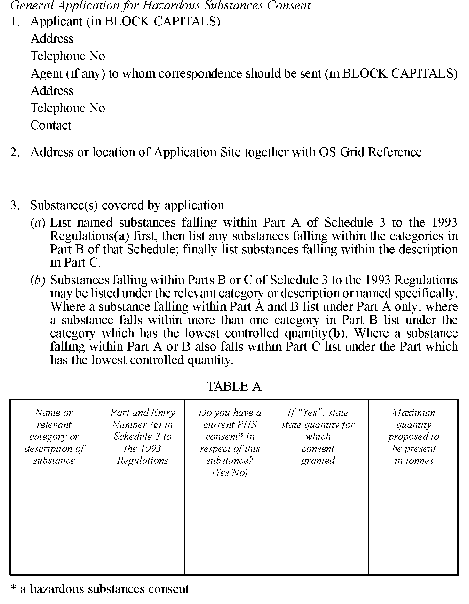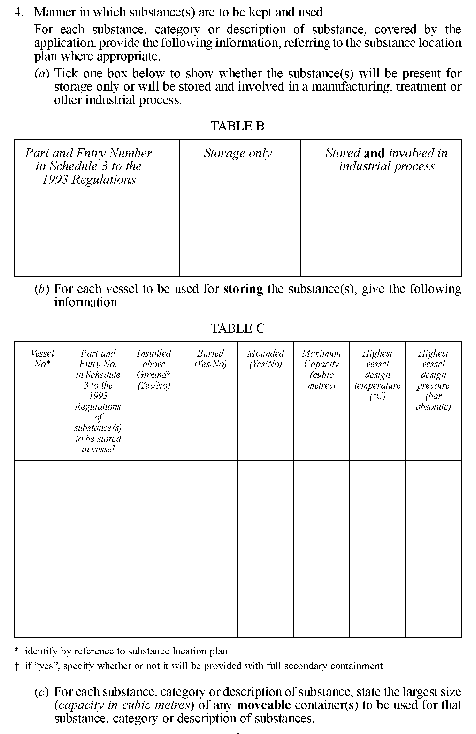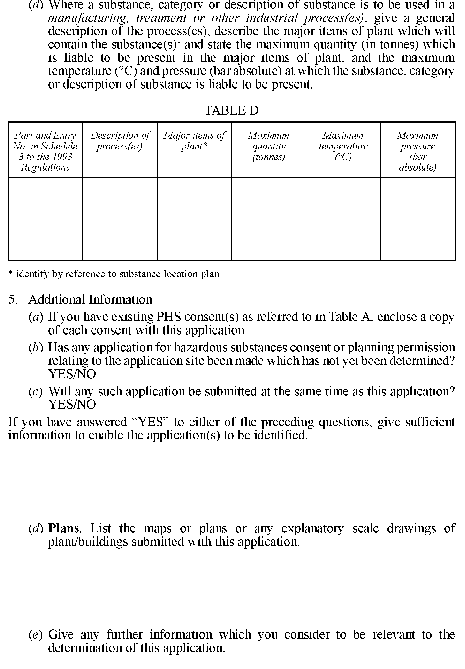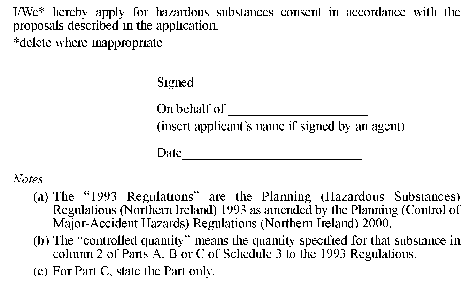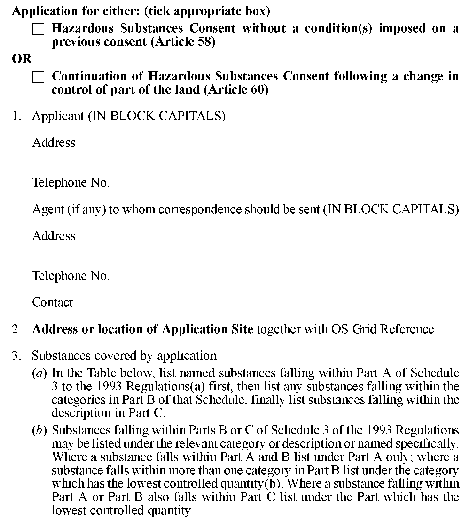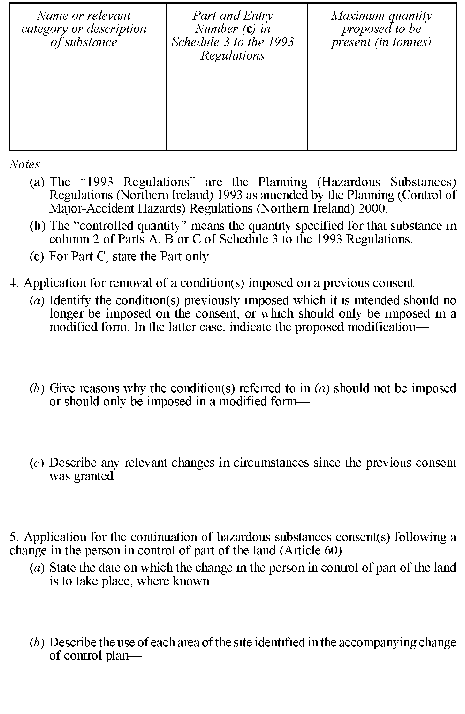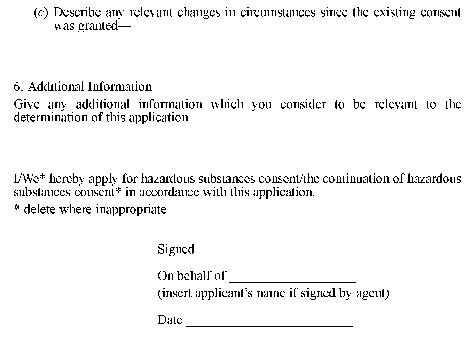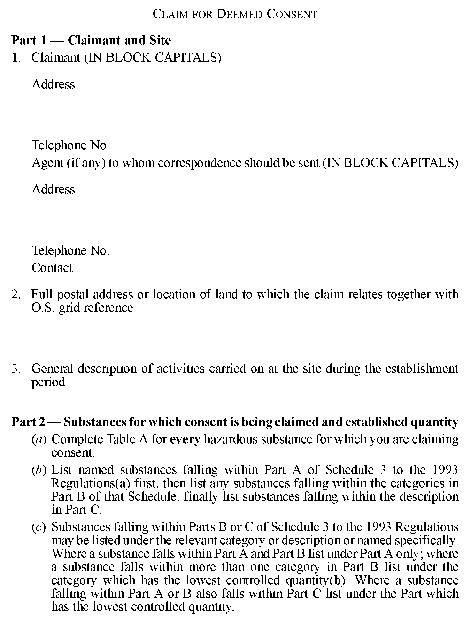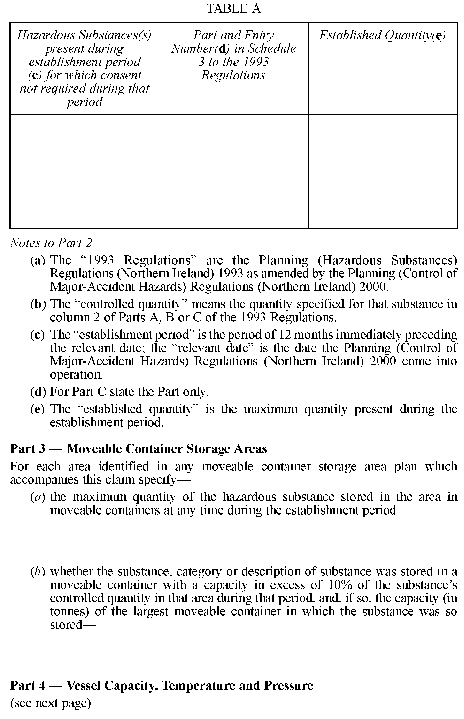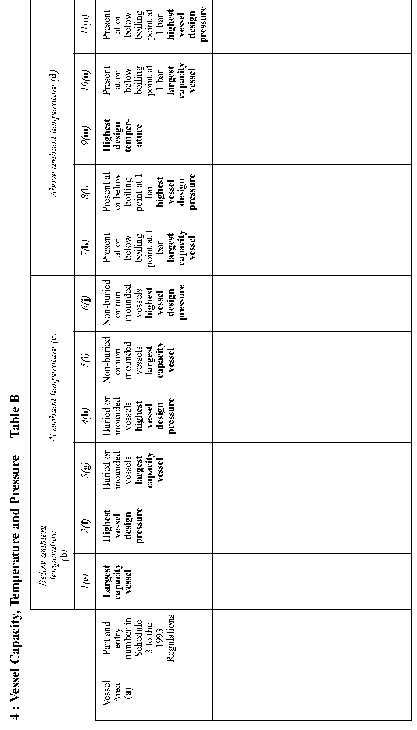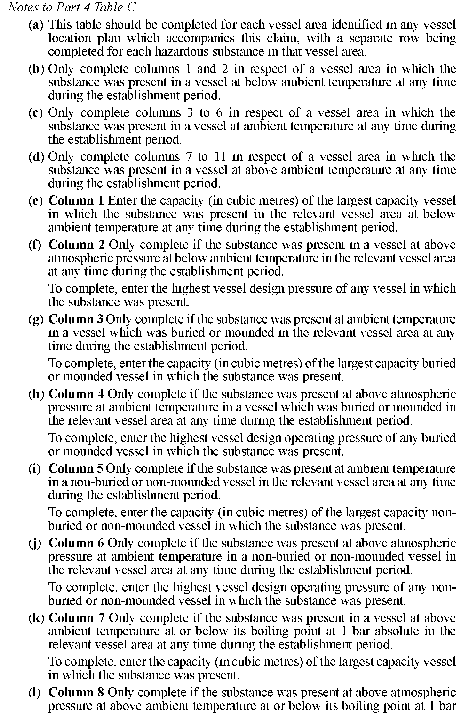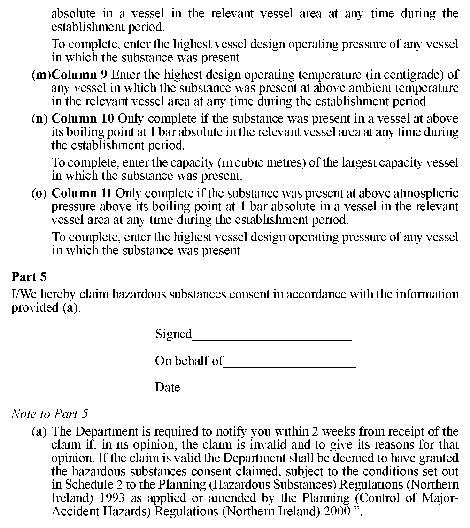Prospective
Regulation 3(7)
SCHEDULE 1N.I.
Commencement Information
I1Sch. 1 in operation at 24.4.2000, see reg. 1(1)
“FORM 1N.I.Planning (Northern Ireland) Order 1991, Article 54(1)The Planning (Hazardous Substances) Regulations (Northern Ireland) 1993 (Regulation 5)
“FORM 2N.I.Planning (Northern Ireland) Order 1991 Articles 58 and 60The Planning (Hazardous Substances) Regulations (Northern Ireland) 1993 (Regulations 5(2) and (3))
“FORM 5N.I.Planning (Northern Ireland) Order 1991, Schedule 4 Paragraph 4(4)The Planning (Hazardous Substances) Regulations (Northern Ireland) 1993 (Regulation 14)
Regulation 3(9)
SCHEDULE 2N.I.
Commencement Information
I2Sch. 2 in operation at 24.4.2000, see reg. 1(1)
Regulations 3(1) and (3)
“SCHEDULE 3N.I.Hazardous Substances and Controlled Quantities
Part AN.I.Named Substances
| Column 1 | Column 2 | Column 3 |
|---|---|---|
| Hazardous Substances | Controlled Quantity (Q) in tonnes | Quantity for the purposes of Note 4 to the notes to Parts A and B (Q*) |
1. Ammonium nitrate to which Note 1 of the notes to Part A applies | 350.00 | — |
2. Ammonium nitrate to which Note 2 of the notes to Part A applies | 1000.00 | 1250.00 |
3. Arsenic pentoxide, arsenic (V) acid and/or salts | 1.00 | — |
4. Arsenic trioxide, arsenious (III) acid and/or salts | 0.10 | — |
5. Bromine | 20.00 | — |
6. Chlorine | 10.00 | — |
7. Nickel compounds in inhalable powder form (nickel monoxide, nickel dioxide, nickel sulphide, trinickel disulphide, dinickel trioxide) | 1.00 | — |
8. Ethyleneimine | 10.00 | — |
9. Fluorine | 10.00 | — |
10. Formaldehyde (concentration ≥ 90%) | 5.00 | — |
11. Hydrogen | 2.00 | 5.00 |
12. Hydrogen chloride (liquefied gas) | 25.00 | — |
13. Lead alkyls | 5.00 | — |
14. commercial propane and commercial butane, and any mixture thereof, when held at a pressure greater than 1.4 bar absolute | Liquefied petroleum gas, including 25.00 | 50.00 |
15. excluding pressurised LPG (entry no. 14) | Liquefied extremely flammable gases 50.00 | — |
16. Natural Gas | 15.00 | 50.00 |
17. Acetylene | 5.00 | — |
18. Ethylene oxide | 5.00 | — |
19. Propylene oxide | 5.00 | — |
20. Methanol | 500.00 | — |
21. and/or salts, in powder form | 4, 4-Methylenebis (2-chloraniline) 0.01 | — |
22. Methylisocyanate | 0.15 | — |
23. Oxygen | 200.00 | — |
24. Toluene diisocyanate | 10.00 | — |
25. Carbonyl dichloride (phosgene) | 0.30 | — |
26. Arsenic trihydride (arsine) | 0.20 | — |
27. Phosphorus trihydride (phosphine) | 0.20 | — |
28. Sulphur dichloride | 1.00 | — |
29. trioxide dissolved in sulphuric acid to form Oleum) | Sulphur trioxide (including sulphur 15.00 | — |
30. polychlorodibenzodioxins (including TCDD), calculated in TCDD equivalent (see Note 3 to the notes to Part A) | Polychlorodibenzofurans and 0.001 | — |
31. 4-Aminobiphenyl and/or its salts; Benzidine and/or salts; Bis(chloromethyl)ether; Chloromethyl methyl ether; Dimethylcarbamoyl chloride; Dimethylnitrosomine; Hexamethylphosphoric triamide; 2-Naphthylamine and/or salts; 1, 3-Propanesultone; 4-Nitrodiphenyl | The following carcinogens— 0.001 | — |
32. Automotive petrol and other petroleum spirits | 5000.00 | — |
33. Acrylonitrile | 20.00 | 50.00 |
34. Carbon disulphide | 20.00 | 50.00 |
35. Hydrogen selenide | 1.00 | 50.00 |
36. Nickel tetracarbonyl | 1.00 | 5.00 |
37. Oxygen difluoride | 1.00 | 5.00 |
38. Pentaborane | 1.00 | 5.00 |
39. Selenium hexafluoride | 1.00 | 50.00 |
40. Stibine (Antimony hydride) | 1.00 | 5.00 |
41. Sulphur dioxide | 20.00 | 50.00 |
42. Tellurium hexafluoride | 1.00 | 5.00 |
43. butane (>70%) | 2, 2-Bis(tert-butylperoxy) 5.00 | 50.00 |
44. (>80%) | 1, 1-Bis(tert-butylperoxy) cyclohexane 5.00 | 50.00 |
45. tert-Butyl peroxyacetate (>70%) | 5.00 | 50.00 |
46. tert-Butyl peroxyisobutyrate (>80%) | 5.00 | 50.00 |
47. tert-Butyl peroxyisopropylcarbonate (>80%) | 5.00 | 50.00 |
48. tert-Butyl peroxymaleate (>80%) | 5.00 | 50.00 |
49. tert-Butyl peroxypivalate (>77%) | 5.00 | 50.00 |
50. Cellulose Nitrate other than— (1) Cellulose nitrate to which the Explosives Act 1875(1) applies; or (2) Cellulose nitrate where the nitrogen content of the cellulose nitrate does not exceed 12.3% by weight and contains not more than 55 parts of cellulose nitrate per 100 parts by weight of solution | 50.00 | — |
51. Dibenzyl peroxydicarbonate (>90%) | 5.00 | 50.00 |
52. Diethyl peroxydicarbonate (>30%) | 5.00 | 50.00 |
53. 2, 2-Dihydroperoxypropane (>30%) | 5.00 | 50.00 |
54. Di-isobutyryl peroxide (>50%) | 5.00 | 50.00 |
55. Di-n-propyl peroxydicarbonate (>80%) | 5.00 | 50.00 |
56. Di-sec-butyl peroxydicarbonate (>80%) | 5.00 | 50.00 |
57. 1, 2, 4, 5-tetroxacyclononane (>75%) | 3, 3, 6, 6, 9, 9-Hexamethyl-5.00 | 50.00 |
58. Methyl ethyl ketone peroxide (>60%) | 5.00 | 50.00 |
59. Methyl isobutyl ketone peroxide (>60%) | 5.00 | 50.00 |
60. Peracetic acid (>60%) | 5.00 | 50.00 |
61. Sodium chlorate | 25.00 | 50.00 |
62. covered by entry 16) which is flammable in air, when held as a gas | Gas or any mixture of gases (not 15.00 | — |
63. substances which is flammable in air when held above its boiling point (measured at 1 bar absolute) as a liquid or as a mixture of liquid and gas at a pressure of more than 1.4 bar absolute (see Note 4 to the notes to Part A) | A substance or any mixture of 25.00 | — |
Notes to Part A
Ammonium Nitrate
1. This applies to ammonium nitrate and ammonium nitrate compounds in which the nitrogen content as a result of the ammonium nitrate is more than 28 per cent by weight (compounds other than those referred to in Note 2) and to aqueous ammonium nitrate solutions in which the concentration of ammonium nitrate is more than 90 per cent by weight.
Ammonium Nitrate
2. This applies to simple ammonium nitrate based fertilisers which conform with the requirements of the Fertilisers Regulations (Northern Ireland) 1992(2) and to composite fertilisers in which the nitrogen content as a result of the ammonium nitrate is more than 28 per cent in weight (a composite fertiliser contains ammonium nitrate with phosphate or potash, or phosphate and potash).
Polychlorodibenzofurans and polychlorodibenzodioxins
3. The quantities of polychlorodibenzofurans and polychlorodibenzodioxins are calculated using the following factors:
International Toxic Equivalent Factors (ITEF) for the congeners of concern (NATO/CCMS(3))
| 2, 3, 7, 8-TCDD | 1 |
| 1, 2, 3, 7, 8-PeDD | 0·5 |
1, 2, 3, 4, 7, 8-HxCDD } 1, 2, 3, 6, 7, 8-HxCDD } 1, 2, 3, 7, 8, 9-HxCDD } | 0·1 |
| 1, 2, 3, 4, 6, 7, 8-HpCDD | 0·01 |
| OCDD | 0·001 |
| 2, 3, 4, 7, 8-PeCDF | 0·5 |
| 1, 2, 3, 7, 8-PeCDF | 0·05 |
1, 2, 3, 4, 7, 8-HxCDF } 1, 2, 3, 7, 8, 9-HxCDF } 1, 2, 3, 6, 7, 8-HxCDF } 2, 3, 4, 6, 7, 8-HxCDF } | 0·1 |
1, 2, 3, 4, 6, 7, 8-HpCDF } 1, 2, 3, 4, 7, 8, 9-HpCDF } | 0·01 |
| OCDF | 0·001 |
(T = Tetra, P = Penta, Hx = Hexa, Hp = Hepta, O = octa)
Entry Number 63
4. The controlled quantity of 25 tonnes in column 2 of entry 63 refers, in the case of a mixture of substances, to the quantity of substances within that mixture held above their boling point (measured at 1 bar absolute).
PART BN.I.CATEGORIES OF SUBSTANCES AND PREPARATIONS NOT SPECIFICALLY NAMED IN PART A
| Column 1 | Column 2 |
|---|---|
| Categories of hazardous substances | Controlled Quantity (Q) in tonnes |
1. VERY TOXIC | 5.00 |
2 TOXIC | 50.00 |
3. OXIDISING | 50.00 |
4. EXPLOSIVE (where the substance or preparation falls within the definition given in Note 2(a) to the notes to Part B, excluding those at a factory or magazine subject to assent procedures under section 7 of the Explosives Act 1875 or those licensed under the Dangerous Substances in Harbour Areas Regulations (Northern Ireland) 1991(4)) | 50.00 |
5. EXPLOSIVE (where the substance or preparation falls within the definition given in Note 2(b) to the notes to Part B, excluding those at a factory or magazine subject to assent procedures under section 7 of the Explosives Act 1875 or those licensed under the Dangerous Substances in Harbour Area Regulations (Northern Ireland) 1991) | 10.00 |
6. FLAMMABLE (where the substance or preparation falls within the definition given in Note 3(a) to the notes to Part B) | 5000.00 |
7. HIGHLY FLAMMABLE (where the substance or preparation falls within the definition given in Note 3(b)(i) to the notes in Part B) | 50.00 |
8. HIGHLY FLAMMABLE liquids (where the substance or preparation falls within the definition given in Note 3(b)(ii) to the notes to Part B) | 5000.00 |
9. EXTREMELY FLAMMABLE (where the substance or preparation falls within the definition given in Note 3(c) to the notes to Part B) | 10.00 |
10. DANGEROUS FOR THE ENVIRONMENT in combination with risk phrases: (i)R50: “very toxic to aquatic organisms” | 200.00 |
(ii)R51: “toxic to aquatic organisms”; and R53: “may cause long term adverse effects in the aquatic environment” | 500.00 |
11. ANY CLASSIFICATION not covered by those given above in combination with risk phrases: (i)R14: “reacts violently with water” (including R14/R15) | 100.00 |
(ii)R29: “in contact with water, liberates toxic gas” | 50.00 |
Notes to Part B
1. Substances and preparations shall be classified for the purpose of this Schedule according to regulation 5 of the Chemicals (Hazard Information and Packaging for Supply) Regulations (Northern Ireland) 1995(5) (“CHIP”) whether or not the substance or preparation is required to be classified for the purposes of those Regulations, or, in the case of a pesticide approved under the Food and Environment Protection Act 1985(6) in accordance with the classification assigned to it by that approval.
2. An “explosive” means—
(a)(i)a substance or preparation which creates the risk of an explosion by shock friction, fire or other sources of ignition (risk phrase(7) R2);
(ii)a pyrotechnic substance is a substance (or mixture of substances) designed to produce heat, light, sound, gas or smoke or a combination of such effects through non-detonating self-sustained exothermic chemical reactions; or
(iii)an explosive or pyrotechnic substance or preparation contained in objects;
(b)a substance or preparation which creates extreme risks of explosion by shock, friction, fire or other sources of ignition (risk phrase R3).
3. “Flammable”, “highly flammable” and “extremely flammable” in categories 6, 7, 8 and 9 mean:
(a)flammable liquids—
substances and preparations having a flash point equal to or greater than 21°C and less than or equal to 55°C (risk phrase R10), supporting combustion;
(b)highly flammable liquids:
(i)substances and preparations which may become hot and finally catch fire in contact with air at ambient temperature without any input of energy (risk phrase R17),
substances which have a flash point lower than 55°C and which remain liquid under pressure, where particular processing conditions, such as high pressure or high temperature, may create major-accident hazards;
(ii)substances and preparations having a flash point lower than 21°C and which are not extremely flammable (risk phrase R11, second indent);
(c)extremely flammable gases and liquids:
(i)liquid substances and preparations which have a flash point lower than 0°C and the boiling point (or, in the case of a boiling range, the initial boiling point) of which at normal pressure is less than or equal to 35°C (risk phrase R12, first indent), and
(ii)gaseous substances and preparations which are flammable in contact with air at ambient temperature and pressure (risk phrase R12, second indent), whether or not kept in the gaseous or liquid state under pressure, excluding liquefied extremely flammable gases (including liquefied petroleum gas) and natural gas referred to in Part A; and
(iii)flammable liquid substances and preparations maintained at a temperature above their boiling point.
Notes to Parts A and B
1. Mixtures and preparations shall be treated in the same way as pure substances provided they remain within the concentration limits set according to their properties under the relevant provisions specified in CHIP, unless a percentage composition or other description is specifically given.
2. In the case of substances and preparations with properties giving rise to more than one classification the lowest thresholds shall apply.
3. Where a substance or group of substances listed in Part A also falls within a category of Part B, the controlled quantities set out in Part A must be used.
4. The addition of hazardous substances to determine the controlled quantity shall be carried out according to the following rule—
if the sum
q1 / Q + q2 / Q + q3 / Q + q4 / Q + q5 / Q + ...>1
(where
q x = the quantity of hazardous substance x (or category of substance) present,
Q = the relevant controlled quantity (Q) from Part A or Part B, except for those substances for which column 3 of Part A contains a quantity Q*, in which case the quantity Q* shall be used in place of the controlled quantity Q in column 2)
then the controlled quantity of each of the substances which are added together in accordance with each of paragraphs 5(a) to (c) below shall be deemed to be present for the purposes of Articles 53(1), 59(2)(a), 61(2)(a) and paragraph 4(7) of Schedule 4 (as applied by the Planning (Control of Major-Accident Hazards) Regulations (Northern Ireland) 2000) of the 1991 Order and of Article 76 (enforcement notice to have effect against subsequent development) of the 1991 Order as modified by regulation 19(1) and Part 2 Schedule 4 of the Hazardous Substances Regulations.
5. The addition rule in paragraph 4 will apply for the following circumstances:
(a)for substances and preparations appearing in Part A at quantities less than their individual controlled quantity present with substances having the same classification from Part B, and the addition of substances and preparations with the same classification from Part B;
(b)for the addition of categories 1, 2 and 10 from Part B present together;
(c)for the addition of categories 3, 4, 5, 6, 7, 8 and 9 from Part B present together.
PART CN.I.SUBSTANCES USED IN AN INDUSTRIAL CHEMICAL PROCESS
| Column 1 | Column 2 |
|---|---|
| Hazardous substances | Controlled quantity |
| Where it is believed that a substance, which is within Part A or Part B, may be generated during loss of control of an industrial chemical process (“HS”), any substance which is used in that process (“S”). | The amount of S which it is believed may generate, on its own or in combination with other substances used in the relevant industrial chemical process, the controlled quantity of the HS in question. |
Notes to Part C
1. The expression “which it is believed may be generated during loss of control of an industrial chemical process” has the same meaning as in the Directive.
2. Where a substance falling within Part A or B also falls within Part C, the classification with the lowest controlled quantity shall apply, subject to Note 3 to the notes to Part A and B.”.
37 & 38 Vict. c. 17
S.R. 1992 No. 187 as amended by S.R. 1995 No. 49
North Atlantic Treaty Organisation, Committee for the Challenges of Modern Society
S.R. 1995 No. 60; relevant amendments are made by S.R. 1997 No. 398
1985 c. 48; relevant amendments are made by the Pesticides (Fees and Enforcement) Act 1989 (c. 27), section 1 and the Pesticides Act 1998 (c. 26) sections 1(2) to (4)
“Risk phrase” is defined in regulation 2 of S.R. 1995 No. 60
